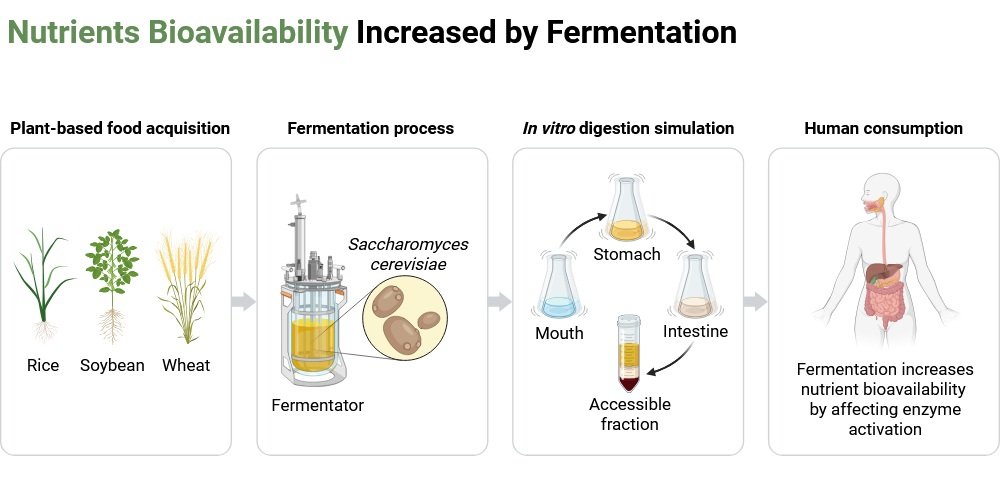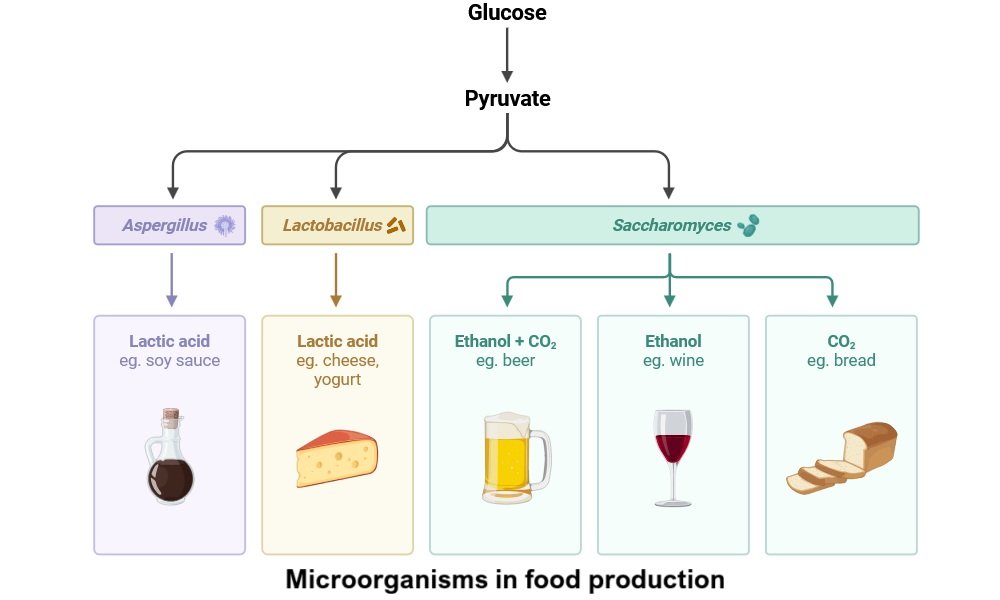Table of Contents
ToggleIntroduction
The microbiology of fermented foods explores the fascinating role of microorganisms in transforming raw ingredients into flavorful, safe, and nutrient-rich products. Fermentation is a biological process in which bacteria, yeasts, and molds metabolize complex organic substances—such as sugars, starches, and proteins—into simpler compounds like acids, alcohols, gases, and peptides. This transformation not only preserves food but also enhances its flavor, aroma, and nutritional value.
Importance of Fermentation in Food
- Preservation: By-products like lactic acid, acetic acid, and ethanol prolong shelf life by lowering pH or establishing conditions that are not conducive to spoilage and pathogenic bacteria.
- Enhancement of Flavor and Sensory Perception: Organic acids, volatile molecules, and protein or lipid degradation products all contribute to the ideal aroma, taste, texture, and mouth feel.
- Nutritional Enhancement: Fermentation can break down anti-nutritional elements such phytates and tannins, increase nutrient bioavailability, create vitamins (particularly B vitamins), and produce peptides that are good for your health.
- Safety: Helpful microbes employ competitive exclusion, acidification, and the manufacture of antimicrobial chemicals to inhibit dangerous microorganisms.

Historically, fermentation has played a significant role in human culinary culture. People used fermentation to keep food, improve its flavor, and guarantee food security long before chemical preservatives or refrigeration. The collected wisdom of various cultures is reflected in traditional fermented foods like cheese, yogurt, bread, wine, beer, pickled vegetables, soy sauce, tempeh, miso, and fermented fish or meat. Science has only recently uncovered the microbiological processes behind these old methods.
Major Microorganisms in Fermented Foods
1. Bacteria
- Lactic Acid Bacteria (LAB): Lactobacillus, Leuconostoc, Pediococcus, Streptococcus thermophilus, and Lactococcus spp. These microbes produce lactic acid, lowering pH and ensuring microbial safety. Found in: Yogurt, cheese, kimchi, sauerkraut, and sourdough.
- Acetic Acid Bacteria (AAB): Acetobacter and Gluconobacter convert ethanol into acetic acid, essential for vinegar and kombucha production.
- Propionibacterium: Produces propionic acid and carbon dioxide, giving Swiss cheese its characteristic holes.
- Bacillus spp.: Bacillus subtilis is common in alkaline fermentations like natto and African fermented beans.
2. Yeasts
- Saccharomyces cerevisiae: The key yeast in alcoholic fermentation—used in beer, wine, and bread.
- Pichia, Kluyveromyces, and Candida: Contribute to flavor and aroma in dairy and soy-based fermentations.
3. Fungi (Molds)
- Aspergillus oryzae: Central to the koji fermentation process, vital for miso, soy sauce, and sake.
- Rhizopus spp.: Used in tempeh production.
- Penicillium spp.: Responsible for cheese ripening in varieties like Camembert and blue cheese.
Major Types of Fermented Foods & Examples with Microbiology
| Category | Examples | Microorganisms Involved | Functional Notes |
| Fermented Meats | Dry/semidry sausages, “luza” | LAB (Lactobacillus sakei, L. plantarum, L. curvatus), CoNS, micrococci, yeasts | LAB lower pH & water activity → preservation; flavor, texture, and safety depend on controlled starter cultures. |
| Fermented Dairy Products | Yogurt, kefir, cheeses | Streptococcus thermophilus, Lactobacillus bulgaricus, Bifidobacterium, yeasts | Produce lactic acid and aroma compounds; affect curd texture and probiotic quality. |
| Fermented Soy/Legume Products | Tempeh, Natto, Miso | Rhizopus spp., Bacillus subtilis, Aspergillus oryzae | Reduce anti-nutritional factors, improve digestibility and umami flavor. |
| Fermented Vegetables | Sauerkraut, Kimchi | Leuconostoc mesenteroides, Lactobacillus plantarum, Weissella spp. | Salt, temperature, and oxygen levels influence microbial succession; produce acidity and flavor. |
| Fermented Beverages | Kombucha, Beer, Wine | Mixed cultures: Saccharomyces, Acetobacter, LAB | Produce organic acids, ethanol, CO₂, and bioactive compounds enhancing flavor and shelf life. |

Technological and Industrial Aspects of Fermentation
- Submerged vs. Solid-State Fermentation: The choice of fermentation medium—solid, liquid, or semi-liquid—necessitates the use of various tools and controls.
- Use of Starter Cultures: Transition from spontaneous fermentation to defined starter cultures to ensure consistent product quality. May be a single-strain, multi-strain, or mixed-species starter.
- Functional Starter Cultures: Starter cultures that have been modified to include features like increased flavor, probiotic benefits, or improved preservation. Starters that are genetically modified can either lessen undesirable metabolites or boost desirable ones.
- Phage-Resistant Starters: The dairy business particularly benefits from the creation of starter strains that are resistant to bacteriophages.
- Genomics and High-Throughput Techniques: Omiques tools and whole genome sequencing to define strains and improve fermentation processes.
- Immobilization & Microencapsulation: The probiotic bacteria are encapsulated to improve their chance of survival during storage and digestion. Microbial cells are immobilized to facilitate reuse or better process management.
- Ultrasound and Innovative Processing Methods: Using ultrasound to accelerate or monitor fermentation, enhance microbial activity, or improve mass transfer.
- Regulatory and safety innovations: Making sure that microbes are safe for human consumption (for example, GRAS status) and following all applicable regulations.
- Genetic and metabolic engineering: Altering microbial metabolic pathways to either produce desired chemicals or lessen undesired ones.
- Labs as Cell Factories: Lactic acid bacteria are employed for a variety of purposes, including acidification, the creation of bioactive chemicals, flavors, and textural elements.
- Patented Approaches: The creation of new cultures, fermentation techniques, or combinations that enhance nutrition, safety, and sensory appeal.
Future Perspectives
- Development New Microbial Strains: The research is concentrating on discovering and utilizing new microbes to improve the fermentation process. The goal of these new strains is to enhance the nutritional value, shelf life, and safety of fermented foods.
- Improvements to Fermentation Methods: To improve the fermentation process for fermented foods, innovations in fermentation methods are being researched. This includes optimizing fermentation efficiency and improving the functional qualities of the finished goods.
- Improvement in Chemical Profiles: The chemical makeup of meals might change during fermentation, resulting in the production of bioactive substances. The goal of future study is to improve the health advantages of fermented foods by gaining a better grasp of these modifications.
- Mapping the Microbiota and Investigating Its Interactions: It is essential to comprehend the microbial groups that participate in fermentation and how they interact with the food matrix. This information can be used to create fermented foods with particular health advantages.
- Enhancing the technological and sensory aspects: Efforts are being made to improve the technological aspects, such as processing efficiency, and sensory qualities, such as taste and texture, of fermented foods in order to satisfy customer preferences.
Conclusion
Fermentation is one of humanity’s oldest yet most advanced food technologies. The microbiology of fermented foods reveals how beneficial microbes preserve food, enrich its flavor, and improve its nutritional profile. Modern science is transforming traditional fermentation through genomics, biotechnology, and food engineering. As consumers increasingly seek natural, probiotic-rich, and sustainable foods, fermented products will play a central role in future diets and global food security.
Frequently Asked Questions (FAQs)
Q1. What are fermented foods?
Fermented foods are products made through microbial action where bacteria, yeasts, or molds convert sugars and other compounds into acids, gases, or alcohol.
Q2. Why are fermented foods beneficial?
They improve gut health, nutrition, and food safety by promoting beneficial microbes and reducing pathogens.
Q3. What microorganisms are commonly used in food fermentation?
Main groups include Lactic Acid Bacteria (LAB), yeasts like Saccharomyces cerevisiae, and molds such as Aspergillus oryzae.
Q4. How does fermentation preserve food?
The production of acids and antimicrobial compounds reduces pH, inhibiting spoilage and pathogenic organisms.
Q5. What is the future of fermented food research?
Emerging areas include metabolic engineering, precision fermentation, probiotic encapsulation, and genome-based starter culture design.
Also Read
- How Microbiology Helps in Vaccine Development: A Comprehensive Guide
- Branches of Microbiology: An Overview of Key Fields
- Importance of Microbiology: Applications, Scope, and Benefits
- What is Microbiology? History, Scopes & Applications
- Microbiology Experiments for Students: A Complete Guide
- Parasitology: An Overview of Parasites, Diseases, and Host Interactions
- Microscopy: Principles, Types, and Applications
- Culture Staining Techniques in Microbiology: Types, Methods, and Applications
- Medical Microbiology Quiz
- Basic Microbiology Quiz
- Immunology Notes

